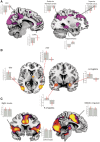Differential neural circuitry and self-interest in real vs hypothetical moral decisions
- PMID: 22711879
- PMCID: PMC3475363
- DOI: 10.1093/scan/nss069
Differential neural circuitry and self-interest in real vs hypothetical moral decisions
Abstract
Classic social psychology studies demonstrate that people can behave in ways that contradict their intentions--especially within the moral domain. We measured brain activity while subjects decided between financial self-benefit (earning money) and preventing physical harm (applying an electric shock) to a confederate under both real and hypothetical conditions. We found a shared neural network associated with empathic concern for both types of decisions. However, hypothetical and real moral decisions also recruited distinct neural circuitry: hypothetical moral decisions mapped closely onto the imagination network, while real moral decisions elicited activity in the bilateral amygdala and anterior cingulate--areas essential for social and affective processes. Moreover, during real moral decision-making, distinct regions of the prefrontal cortex (PFC) determined whether subjects make selfish or pro-social moral choices. Together, these results reveal not only differential neural mechanisms for real and hypothetical moral decisions but also that the nature of real moral decisions can be predicted by dissociable networks within the PFC.
Figures



References
-
- Ajzen I, Brown TC, Carvajal F. Explaining the discrepancy between intentions and actions: the case of hypothetical bias in contingent valuation. Personality and Social Psychology Bulletin. 2004;30(9):1108–21. - PubMed
-
- Akitsuki Y, Decety J. Social context and perceived agency affects empathy for pain: an event-related fMRI investigation. NeuroImage. 2009;47(2):722–34. - PubMed
-
- Amodio DM, Frith CD. Meeting of minds: the medial frontal cortex and social cognition. Nature reviews. Neuroscience. 2006;7(4):268–77. - PubMed
-
- Apperly IA, Samson D, Chiavarino C, Bickerton WL, Humphreys GW. Testing the domain-specificity of a theory of mind deficit in brain-injured patients: evidence for consistent performance on non-verbal, “reality-unknown” false belief and false photograph tasks. Cognition. 2007;103(2):300–21. - PubMed
-
- Baumgartner T, Fischbacher U, Feierabend A, Lutz K, Fehr E. The neural circuitry of a broken promise. Neuron. 2009;64(5):756–70. - PubMed
Publication types
MeSH terms
Grants and funding
LinkOut - more resources
Full Text Sources
Miscellaneous

